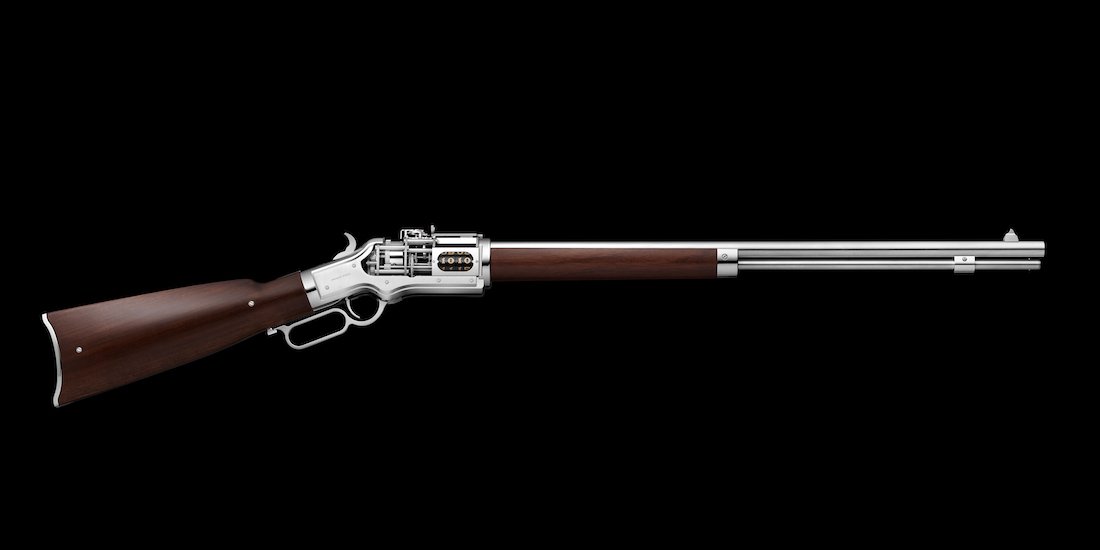Today, the partnership between The Unnamed Society and l’Epée 1839 opens the second chapter of its unfolding history. With Golden Boy comes the second stunning creation imagined for those who set the bar for the Art of Gifting a bit higher than the rest, for appreciators of the finer things, and for visionary collectors. The Golden Boy clock remains true as ever to the spirit of “creating the impossible that defies the imagination” by looking not just at a timekeeper as an expression of aesthetic, engineering and artisanship excellence, but as a true witness of its time. Golden Boy is the logical sequel to the Pancho Villa’s Bisley Colt clock.
Nicknamed the ‘Gun that Won the West,’ the Winchester Rifle remains one of the most iconic firearms of all time. Used by both lawmen and outlaws in the Old West, the Winchester rifle so perfectly embodies the legendary struggle between the peacekeepers and the bandits. Favored by many notable figures such as Billy the Kid, Butch Cassidy, and Buffalo Bill it has become a symbol of that time. For the gun that inspired Golden Boy, the year is 1866. The place: a vast country born less than a century before from the purest of desires, self-determination. A country in the process of inventing itself. The conquest of the West is still underway. And unknown lands also mean unknown dangers. It is best to be prepared. Many of those who ultimately succeeded in staking —and protecting— their claim in those wild days would agree that good preparation also meant owning a gun. And knowing how to use it.
And those who owned a Winchester ‘Yellow Boy’ 1866 were said to be better prepared than others. By the way, it wasn’t the settlers or bandits who came up with the term ‘Yellow Boy’ as shorthand for their trusted rifle. ‘Yellow Boy’ was what the Indians said, when they saw the shiny brass-alloy receiver that housed the cocking and loading mechanism of the lever action rifle. They traded many goods to acquire these ‘fire sticks,’ which put them on an equal footing against those who encroached on their territory. Historians all agree that the Indian victory at Little Big Horn in 1876, one of the bloodiest battles in the History of the American West was in large part due to the fact that the warriors under Sitting Bull’s command were equipped with Yellow Boys. The lever action rifle permitted rapid reloading and accurate shooting, even on a cantering horse. The US Army stood little chance with their breach-loaded, single-shot Springfield Model 1873 rifles. If you are wondering why the US Army didn’t use lever action rifles, the answer is tragically simple: the lever action rifle is very difficult to handle for a soldier lying on the ground in the prone or ‘sniper’ position.
The Golden Boy clock by L’Epée 1839 has the same dimensions and weight as the original, the same feel and heft. Holding it is holding the legend. Beholding it is glimpsing the amazing era that defined a nation and fired the imagination of every generation born since. With Golden Boy, The Unnamed Society is not just opening a new chapter in the figurative sense, but in the literal sense as well.
Arnaud Nicolas, CEO of L’Épée says: “Golden Boy is our second project with The Unnamed Society and a natural continuation of the Pancho Villa’s Bisley Colt we created together. Bolting a clock to a gun was never an option, so rethinking the original rifle’s ingenious lever action mechanism as a clock calibre seemed like an irresistible challenge. It wasn’t The result is a work of engineering that transcends its function into a work of art, true to the DNA of The Unnamed Society.”
L’Épée captures this defining movement of the hand as it loads the round and prepares the gun for firing: by having the clock mechanism wound —‘loaded’— in exactly the same way. By actioning the lever 15 times —as if loading 15 bullets one after the other— the mechanism is fully wound for a 7-day power reserve. In its own unique way, the Golden Boy clock captures not just the reality of the original as it was treasured and used in a time when your life could depend on how well you handled your rifle. It evokes the emotions that must have coursed through many a mind in situations vividly recounted in sepia-colored photographs, personal diaries paintings, movies and novels.
It is one thing to hold and handle the Golden Boy clock, and feel transported into another age. Two ages in fact: the age in which the buffalo roamed the great plains, wagon treks set out into the unknown west, and protecting your property and legitimate defense took on a broader definition than today; and the age of your own childhood, when playing the various roles that defined the conquest of the west —cowboy, Indian, soldier, settler— would first fill afternoons and then late night dreams. Golden Boy takes you there. And then it is quite another thing to see Golden Boy displayed on its bespoke stand that comes at no extra cost, because together they form a whole. Resting on its display on a desk, table or mantel, Golden Boy is an immediate presence in the room. When the display is placed on a wall, Golden Boy becomes a painting telling not just one story, but thousands. Rarely has an object had such an uncanny effect of transfiguring the setting in which it is displayed. For the receiver, barrel and tubular magazine, the owner can choose from steel, 18K yellow, rose or white gold, and palladium. For the stock and forestock, from a selection of exotic woods.
Sticker Price $48,400 USD to $50,700 USD depending on finish and type of wood. For more info on L’Epée 1839 click here.





















